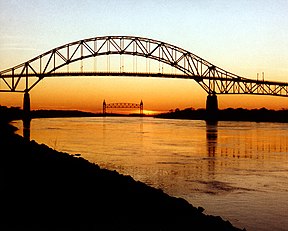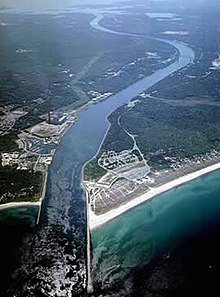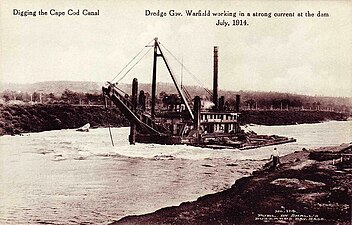geo.wikisort.org - River
The Cape Cod Canal is an artificial waterway in the U.S. state of Massachusetts connecting Cape Cod Bay in the north to Buzzards Bay in the south, and is part of the Atlantic Intracoastal Waterway. The approximately seven-mile-long (11 km) canal traverses the neck of land joining Cape Cod to the state's mainland. It mostly follows tidal rivers widened to 480 feet (150 m) and deepened to 32 feet (9.8 m) at mean low water, shaving 135 miles (217 km) off the journey around the Cape for its approximately 14,000 annual users.[2]
| Cape Cod Canal | |
|---|---|
 The Bourne Bridge with the Cape Cod Canal Railroad Bridge in distance | |
 Location of the Cape Cod Canal | |
| Location | Barnstable County, Massachusetts |
| Country | United States |
| Coordinates | 41°45′51″N 70°34′06″W |
| Specifications | |
| Length | 7 miles (11 km) |
| Maximum boat length | 825 feet (251 m) |
| Maximum boat draft | 32 feet (9.8 m) |
| Maximum boat air draft | 135 feet (41 m) |
| Locks | None |
| Status | Open |
| Navigation authority | U.S. Army Corps of Engineers |
| History | |
| Original owner | Cape Cod & New York Canal Company |
| Principal engineer | William Barclay Parsons |
| Construction began | June 22, 1909 |
| Date of first use | July 29, 1914 |
| Geography | |
| Start point | Cape Cod Bay |
| End point | Buzzards Bay |
Most of the canal is located in the town of Bourne, but its northeastern terminus is in Sandwich. Scusset Beach State Reservation lies near the canal's north entrance, and the Massachusetts Maritime Academy is near its south. A swift-running current changes direction every six hours and can reach 5.2 miles per hour (8.4 km/h) during the receding ebb tide. The waterway is maintained by the United States Army Corps of Engineers and has no toll fees. It is spanned by the Cape Cod Canal Railroad Bridge, the Bourne Bridge, and the Sagamore Bridge. Traffic lights at either end govern the approach of vessels over 65 feet (20 m).
The canal is occasionally used by whales and dolphins,[4] including endangered North Atlantic right whales; these can cause closure of the canal.[5][6]
History

Construction of a canal was first considered by Myles Standish of the Plymouth Colony in 1623, and the Pilgrims scouted the low-lying stretch of land between the Manomet and Scusset rivers for potential routes. William Bradford established the Aptucxet Trading Post in 1627 at the portage between the rivers. Trade prospered with the American Indians of Narragansett Bay and the Dutch of New Netherland, and this was a major factor enabling the Pilgrims to pay off their indebtedness.[7] In 1697, the General Court of Massachusetts considered the first formal proposal to build the canal but took no action. In 1717, a canal was created in Orleans, Massachusetts called Jeremiah's Gutter which spanned a narrower portion of the Cape some distance to the east, but it only remained active until the late 1800s. More energetic planning with surveys took place repeatedly in 1776 (by George Washington), 1791, 1803, 1818, 1824–1830, and 1860. None of these efforts came to fruition.[citation needed]
The first attempts at actually building a canal did not take place until the late 19th century; earlier planners either ran out of money or were overwhelmed by the project's size. The engineers finally decided which route to take through the hillsides by connecting and widening the Manomet and Scusset Rivers. The first actual excavation began in 1880, when the Cape Cod Ship Canal Company hired 400 immigrant Italian laborers to begin digging with shovels and wheelbarrows. The effort ran out of money almost immediately, and the laborers were unpaid and forced to beg for food in Sandwich. In 1883, the Cape Cod Ship Canal Company reorganized. Under engineer Frederick Lockwood, the company used a bucket dredge to clear nearly a mile of channel through the Sandwich marshes, before shutting down in 1891. [8]: 20–22
Private construction

On June 22, 1909, construction finally began for a working canal under the direction of August Belmont Jr.'s Boston, Cape Cod & New York Canal Company using designs by engineer William Barclay Parsons. The canal engineers encountered many problems, such as huge boulders underwater (much of Cape Cod is a moraine—see geology of Cape Cod). Divers were hired to blow them up, but the effort slowed dredging. Another problem was cold winter storms which forced the engineers to stop dredging altogether and wait for spring.[9] Nevertheless, the canal opened on a limited basis on July 29, 1914,[10] and it was completed in 1916. The privately owned toll canal had a maximum width of 100 feet (30 m) and a maximum depth of 25 feet (7.6 m), and it took a somewhat difficult route from Phinney Harbor at the head of Buzzards Bay.[11] Several accidents occurred due to the narrow channel and navigation difficulty, and these limited traffic and tarnished the canal's reputation. Toll revenues failed to meet investors' expectations as a result, despite shortening the trade route from New York City to Boston by 62 miles (100 km).[12]
Public takeover and expansion

The German U-boat U-156 surfaced three miles (5 km) off Orleans, Massachusetts on July 21, 1918 and shelled the tugboat Perth Amboy and her string of four barges. The Director General of the United States Railroad Administration took over jurisdiction and operation of the canal four days later under a presidential proclamation. The United States Army Corps of Engineers re-dredged the channel to 25 feet (7.6 m) deep while it remained under government control until 1920. In 1928, the government purchased the canal for $11.4 million as a free public waterway, and $21 million was spent between 1935 and 1940 increasing the canal's width to 480 feet (150 m) and its depth to 32 feet (9.8 m).[13] As a result, it became the widest sea-level canal of its time.[14] The southern entrance to the canal was rebuilt for direct access from Buzzards Bay rather than through Phinney Harbor. Before construction began, the Massachusetts Institute of Technology built a huge scale model of the canal (9 feet to a mile, roughly 1⁄587 actual size) to study the hydraulic effects of tidal currents on the enlarged and rerouted canal.[15]
World War II
During World War II, shipping again used the canal to avoid U-boats patrolling offshore. It was protected by coastal artillery batteries at the Sagamore Hill Military Reservation at the northern entrance and the Butler Point Military Reservation at the southern entrance. The artillery was never fired in defense of the canal.[16][17]
The Mystic Steamship Company's collier SS Stephen R. Jones was grounded and sank in the canal on June 28, 1942. Shipping was routed around Cape Cod, and one diverted ship, the Liberty ship SS Alexander Macomb, was torpedoed by the German submarine U-215 on July 3 with the loss of 10 lives. The canal reopened on July 31 after the wrecked Stephen R. Jones was removed with the help of 17 tons of dynamite.[18]
Recreational uses
Cape Cod Canal | ||||||||||||||||||||||||||||||||||||||||||||||||||||||||
|---|---|---|---|---|---|---|---|---|---|---|---|---|---|---|---|---|---|---|---|---|---|---|---|---|---|---|---|---|---|---|---|---|---|---|---|---|---|---|---|---|---|---|---|---|---|---|---|---|---|---|---|---|---|---|---|---|
| ||||||||||||||||||||||||||||||||||||||||||||||||||||||||
The canal is used extensively by recreational and commercial vessels. Service roads on both sides of the canal provide access for fishing and are heavily used by in-line skaters, bicyclists, and walkers. Several parking areas are maintained at access points. Bourne Scenic Park is leased by the Corps of Engineers to the Town of Bourne Recreation Authority for use as a tent and RV campground adjacent to the Canal.[19]
The Army Corps of Engineers maintains the Cape Cod Canal Visitor Center which introduces visitors to the history, features, and operation of the canal. Features include a retired 41-foot (12 m) US Army Corps of Engineers patrol boat, a 46-seat theater showing continuous DVD presentations on canal history, canal flora and fauna, real time radar and camera images of the waterway, and a variety of interactive exhibits. Corps Park Rangers staff the center and provide free public programs on a variety of subjects. The Visitor Center is open seasonally from May to October, and admission is free. It is located on Moffitt Drive in Sandwich near the canal's east end. A second seasonally staffed center is at the Herring Run along Scenic Highway.[20]
Scusset Beach State Reservation lies just north of the east end of the canal and offers beach facilities as well as tent and RV camping. A 0.7-mile (1.1 km) trail there leads to Sagamore Hill, once an Indian meeting ground and the site of a World War II coastal fortification.[19] Bournedale Hills Trail extends 1.4 miles (2.3 km) along the north side of the Canal from Bourne Scenic Park campground to the Herring Run. The trail includes a 0.8-mile (1.3 km) self-guided loop which interprets the Canal's historic and natural features.[19]
Fictitious tunnel
A spoof became popular during the late 20th century concerning a fictitious road tunnel, allegedly built in the 1960s under the Cape Cod Canal.[21] It came into popular usage in Massachusetts as a commentary on the severe traffic entering and exiting Cape Cod during the summer months. Since 1994, decals have been sold in shops around the Cape as popular souvenirs purporting to be "permits" allowing the bearer to use the tunnel; the popularity of these "permits" briefly led to a lawsuit among several different sellers.[22][23]
Gallery
- Cape Cod Canal
- Bourne Bridge
- Railroad Bridge
- Sagamore Bridge
- The Gov. Warfield digging the canal in 1914
 A 1922 map of the Cape Cod Canal, showing bridges, mooring points, and other features
A 1922 map of the Cape Cod Canal, showing bridges, mooring points, and other features
See also
- List of crossings of the Cape Cod Canal
References
- New England District (November 12, 2015). "Cape Cod Canal (Buzzards Bay and Sandwich, Mass.)". U.S. Army Corps of Engineers. Retrieved February 24, 2016.
- Pearson, Samantha. "Dolphins in Cape Cod Canal Saturday" (Video). Boston: WBZ-TV.
- Bragg, Mary Ann (May 9, 2015). "Cape Cod Canal closed after right whale sighting". Cape Cod Times.
- "Favorite Places". Archived from the original on September 8, 2008.
- Reid, William J. (August 1965). "The Military Value of the Cape Cod Canal". United States Naval Institute Proceedings. p. 83.
- Timothy, Orwig (2013). Cape Cod Canal. Arcadia Publishing. ISBN 9781467120364.
- New England District. "Cape Cod Canal". US Army Corps of Engineers. Archived from the original on December 5, 2003.
- "The Independent". Retrieved February 24, 2016.
- "Massachusetts Estuaries Project – Map & List of Targeted Estuaries". Massachusetts Department of Environmental Protection. Archived from the original on June 9, 2012. Retrieved August 10, 2012.
- "The Opening of the Cape Cod Canal". Bulletin of the American Geographical Society. Vol. 46, no. 11. 1914. pp. 832–834. doi:10.2307/200951. JSTOR 200951.
- Reid (1965), pp. 85–86.
- "Cape Cod Canal at Army Corps of Engineers website". Archived from the original on June 18, 2009. Retrieved May 23, 2009.
- "Model of Cape Cod Canal Helps Study of Channel". Popular Mechanics. April 1936. p. 567 – via Google Books.
- "Sagamore Hill Military Reservation". American Forts Network.
- "Butler Point Military Reservation". American Forts Network.
- Reid (1965), pp. 89–90.
- New England District. "Recreation Along the Cape Cod Canal". U.S. Army Corps of Engineers. Archived from the original on November 28, 2009. Retrieved October 31, 2009.
- "Cape Cod Canal (Buzzards Bay and Sandwich, Mass.), New England District". U.S. Army Corps of Engineers. Retrieved July 27, 2018.
- "Cape Cod Canal". newenglandtravelplanner.com.
- Felix Carroll, "A case of tunnel vision", Cape Cod Times, October 2, 1999.
- James Carlson, "Sticking around", Cape Cod Times, September 3, 2004.
Further reading
- Butler, Gerald (2002). The Military History of the Cape Cod Canal. Arcadia Publishing. ISBN 0738510092.
- Massachusetts General Court Joint Committee on Ship Canal to Connect Barnstable Bay and Buzzard's Bay (1864). Report of the Joint Committee of 1860 upon the proposed canal to unite Barnstable and Buzzard's bays (Report). Boston: Wright & Potter, State Printers. pp. 10–22. Retrieved July 24, 2014.
- Reid, William James (1961). The building of the Cape Cod Canal, 1627–1914. New York: Privately Printed. OCLC 987742.
- Timothy, Orwig (2013). Cape Cod Canal. Arcadia Publishing. ISBN 9781467120364.
External links
На других языках
[de] Cape Cod Canal
Der Cape-Cod-Kanal ist eine künstliche Wasserstraße im US-Bundesstaat Massachusetts, die die Cape Cod Bay im Norden mit der Buzzards Bay im Süden verbindet und Teil des Atlantic Intracoastal Waterway ist. Er durchmisst einen natürlichen Isthmus, der Cape Cod mit dem Festland verbindet. Auf einem Großteil seiner Strecke folgt der Kanal Tideflüssen von bis zu 150 m Breite und 9,8 m Tiefe (bei Niedrigwasser). Er kürzt die Route um das Kap um 217 km ab und wird jährlich von rund 14.000 Wasserfahrzeugen genutzt.[1]- [en] Cape Cod Canal
[it] Canale di Capo Cod
Il Canale di Capo Cod è una via d'acqua artificiale nello stato del Massachusetts che collega la Baia di Capo Cod a nord con la Baia di Buzzards a sud.[ru] Кейп-Код (канал)
Кейп-Код (англ. Cape Cod Canal) — канал в Массачусетсе.Другой контент может иметь иную лицензию. Перед использованием материалов сайта WikiSort.org внимательно изучите правила лицензирования конкретных элементов наполнения сайта.
WikiSort.org - проект по пересортировке и дополнению контента Википедии




